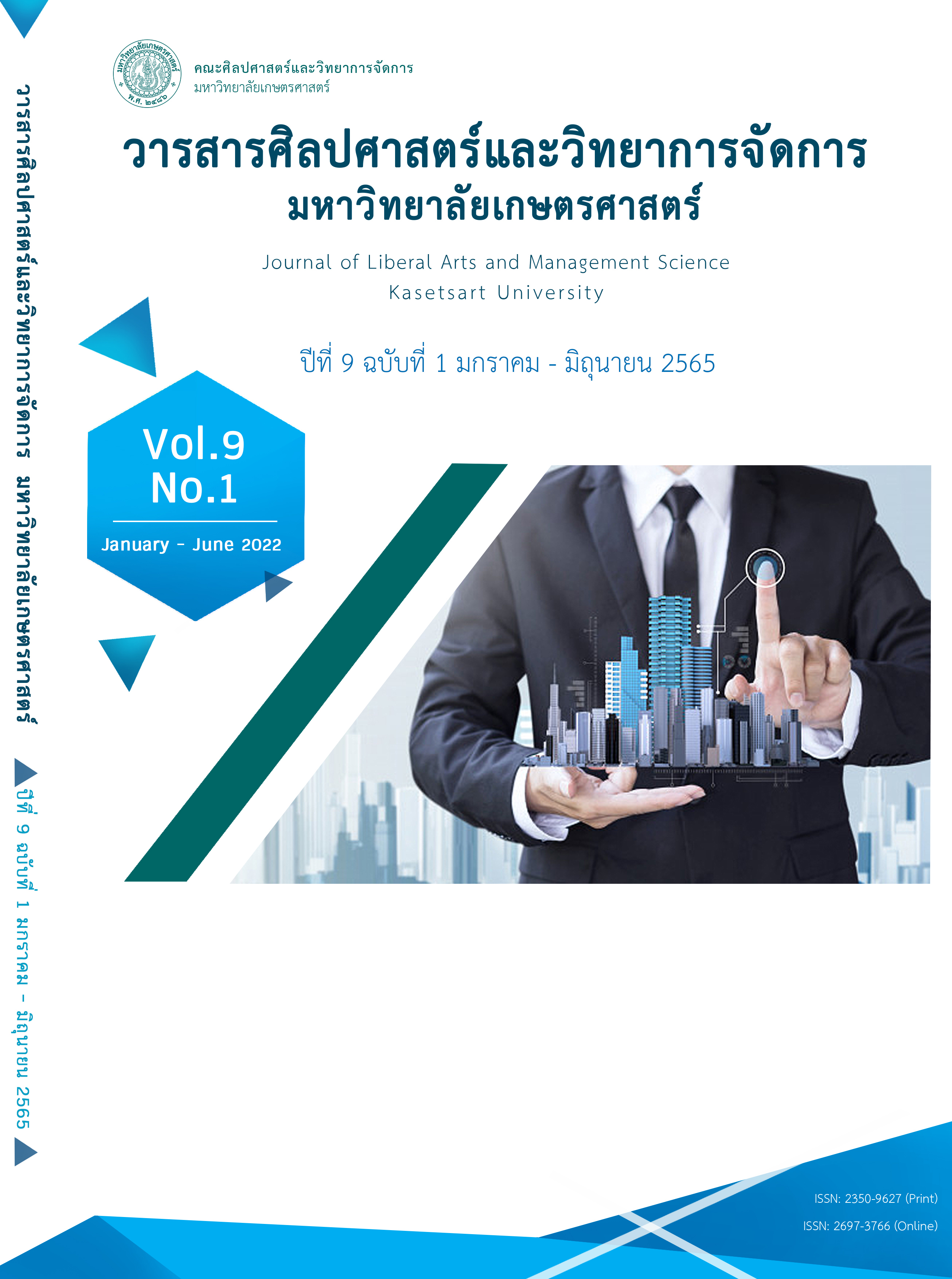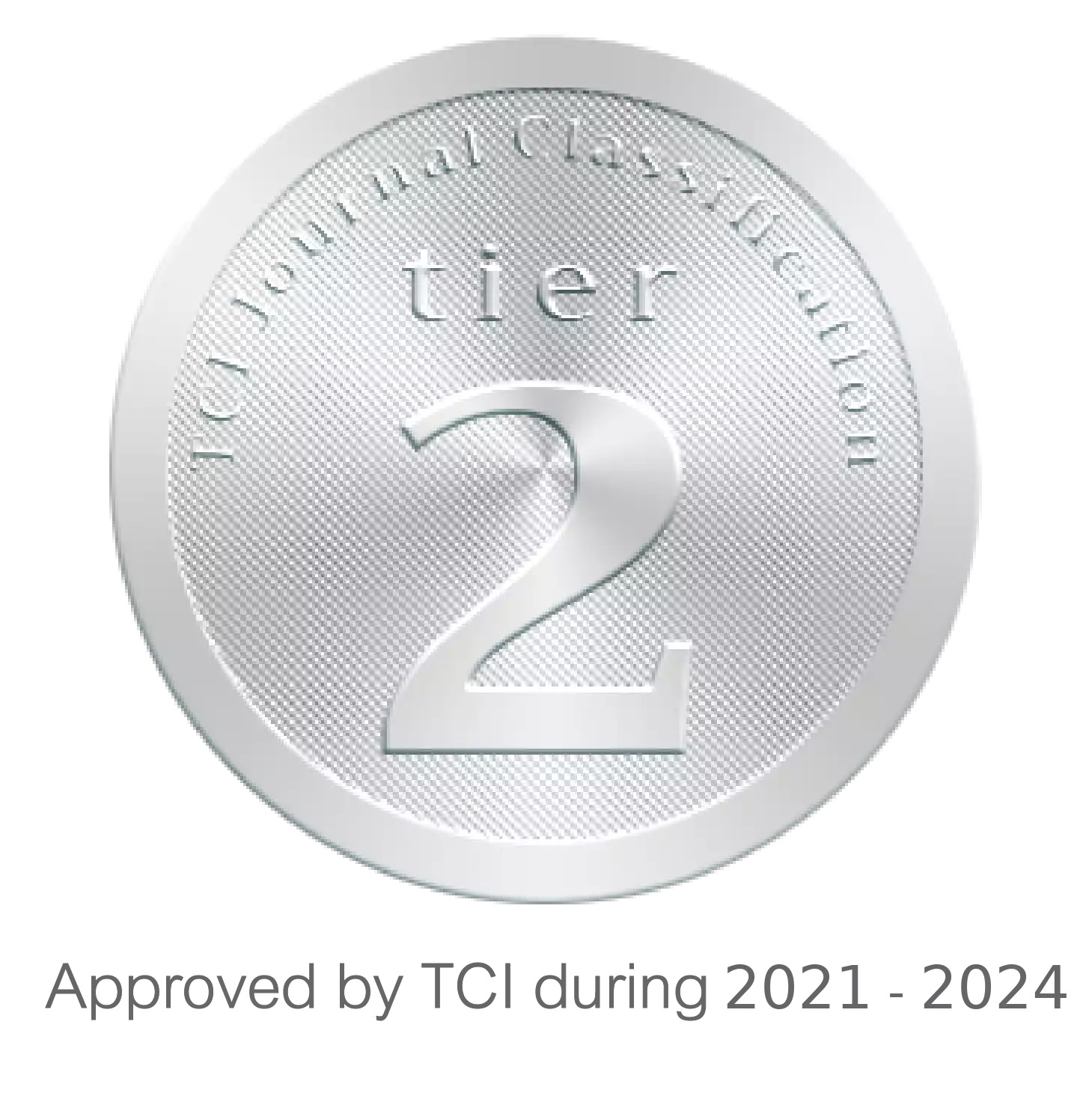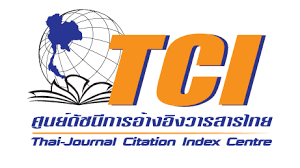ผลกระทบของการมุ่งเน้นการตลาดและการจัดการโซ่อุปทานสีเขียว ต่อการพัฒนาด้านสิ่งแวดล้อมที่ยั่งยืนของธุรกิจโรงแรม ในภาคตะวันออกเฉียงเหนือของประเทศไทย
คำสำคัญ:
การจัดการโซ่อุปทานสีเขียว, การพัฒนาด้านสิ่งแวดล้อมที่ยั่งยืน, การมุ่งเน้นการตลาดบทคัดย่อ
การศึกษางานวิจัยนี้มีวัตถุประสงค์เพื่อวิเคราะห์องค์ประกอบและอิทธิพลของการมุ่งเน้นการตลาด การจัดการโซ่อุปทานสีเขียวมีอิทธิพลต่อการพัฒนาสิ่งแวดล้อมที่ยั่งยืนของธุรกิจโรงแรม กลุ่มตัวอย่างที่ใช้ในการศึกษาคือธุรกิจโรงแรมในภาคตะวันออกเฉียงเหนือ จำนวน 220 แห่ง งานวิจัยนี้ใช้การวิเคราะห์สถิติเชิงอนุมานด้วยแบบจำลองสมการโครงสร้าง ซึ่งผลการทดสอบสมมติฐานพบว่า แบบจำลองสมการโครงสร้างที่พัฒนาขึ้นมามีความสอดคล้องกับข้อมูลเชิงประจักษ์โดยมีค่าความแปรปรวนร่วมเท่ากัน โดยผ่านเกณฑ์มาตรฐานด้วยสถิติ X2=43.209, df=41 (chi-square/df=1.05), p-value=0.377, CFI=0.991, GFI=0.966, RMSEA=0.016 และ SRMR=0.006 สามารถอธิบายได้ว่า การมุ่งเน้นการตลาดไม่มีอิทธิพลทางตรงต่อการพัฒนาสิ่งแวดล้อมที่ยั่งยืน โดยมีค่าขนาดอิทธิพลเท่ากับ 0.001 (p=0.997) การมุ่งเน้นการตลาดมีอิทธิพลทางอ้อมต่อการพัฒนาสิ่งแวดล้อมที่ยั่งยืนโดยผ่านการจัดการโซ่อุปทานสีเขียวอย่างมีนัยสำคัญทางสถิติที่ 0.05 มีค่าสัมประสิทธิ์แสดงถึงขนาดอิทธิพลทางอ้อมเท่ากับ 0.650 การมุ่งเน้นการตลาดมีอิทธิพลทางตรงเชิงบวกต่อการจัดการโซ่อุปทานสีเขียว อย่างมีนัยสำคัญที่ 0.01 มีค่าสัมประสิทธิ์แสดงถึงขนาดอิทธิพลเท่ากับ 0.733 และการจัดการโซ่อุปทานสีเขียวมีอิทธิพลต่อการพัฒนาสิ่งแวดล้อมที่ยั่งยืน อย่างมีนัยสำคัญทางสถิติที่ 0.01 มีค่าสัมประสิทธิ์แสดงถึงขนาดอิทธิพลเท่ากับ 0.886 ดังนั้น ตัวแปรมีความสัมพันธ์กันในลักษณะการเชื่อมโยงและสอดคล้องไปในแนวทางเดียวกันอย่างมีนัยสำคัญทางสถิติ
##plugins.generic.usageStats.downloads##
เอกสารอ้างอิง
Amol Singh and Ashish Trivedi. (2015). Sustainable green supply chain management: trends and current practices. Competitiveness Revies, 26(3), 265-288.
Baron, R. and Kenny, D. A. (1986). The moderator-mediator variable distinction in social psy-chological research: conceptual, strategic, and statistical considerations. Journal of Personality and Social Psychology, 51(6), 1173.
Basher V. (2010). Vendor selection and quota allocation by using fuzzy topics and linear programming. Master of Engineering in Production Engineering. University of Delhi: India.
Carter, C. R., & Carter, J. R. (1998). Interorganizational determinants of environmental purchasing: initial evidence from the consumer products industries. Decision Sciences, 29(3), 659-684.
Ciegis, R., & Zeleniute, R. (2008). Ekonomikos pletra darnaus vystymosi aspektu. Taikomoji ekonomika: sisteminiai tyrimai, 2(1), 35-52.
Dawes, J., Romaniuk, J., & Mansfield, A. (2009). Generalized pattern in competition among tourism destinations. International Journal of Culture, Tourism and Hospitality Research, 3(1), 33-53.
Edwards, J. R., & Lambert, L. S. (2007). Methods for integrating moderation and mediation: A general analytical framework using moderated pathanalysis. Psychological Methods, 12(1), 1–22.
Elkington, J. (1994). Towards the sustainable corporation. California Management Review, 90(100). Winter.
Fortes, J. (2009). Green supply chain management: A literature review. Otago Management Graduate Review, 7, 51-62.
Green Kenneth, W., Inman, R. Anthony, Sower Victor, E., Zelbst Pamela, J. (2019). Impact of JIT, TQM and green supply chain practices on environmental sustainability. Journal of Manufacturing Technology Management, 30(1), 26-47.
Hair, J., Black, W., Babin, B., Anderson, r.,and Tatham, R. (2010). Multivariate data analysis. (7th ed). New Jersey: Pearson Educational International.
Hu, L. T., and Bentler, P. M. (1999). Evaluating model fit. In R. H. Hoyle (Ed). Structural Thousand Oaks, CA: Sage. Equation modelling: Concepts, issues, and applications. 76-99.
Hunt. (2002). Doctoral seminars in marketing theory: For incorporating the history of marketing practice and thought. Journal of Historical Research in Marketing. ISSN: 1755-750X.
James R. Stock. (1998). Development and Implementation of Reverse Logistics Programs, Oak-Brook, Illionois, Councilof Logistics Management.
John T.Mentzer. (2007). A market orientation in supply chain management. Journal of the Academy of Marketing Science, 35(4), 507-522.
Jose Antonio, Rosa Madhubalan and Viswanathan. (2007). Market orientation and performance in low-income countries: The case of Zimbabwean retailers. Product and Market Development for Subsistence Marketplaces. 215-257.
Kaynaka, E., & Kara, A. (2004). Market orientation and organizational performance: A comparison of industrial versus consumer companies in mainland China using market orientation scale (MARKOR). Journal of Industrial Marketing Management, 33(8), 743-753.
Kelloway, E. Kevin. (1998). Using LISREL for structural equation modeling. New Jersey: Sage Publication.
Kline, R. B. (2005). Principles and practice of structural equation modeling. New York: Guilford Press.
Koh SCL, Demirbag M, Bayraktar E, Tatoglu E, Zaim S. (2007). The impact of supply chain management practices on performance of SMEs. Industrial Management & Data Systems, 107(1), 103-124.
LMI Government Consulting. (2005). Best practices in implementing green supply chain. supply chain world conference and exposition, April, North America.
Mohanty RP, Deshmukh SG. (2005). Supply chain management: theories and practices. Delhi: Biztantra Publication.
Morgan-Lopez, A., Castro, F., Chassin, L., & MacKinnon, D. (2003). A mediated moderation model of cigarette use among mexican american youth. Addictive Behaviors, 28, 583-589.
Ngai, J. C. H., & Ellis, P. (1998). Market orientation and business performance: some evidence from Hong Kong. International marketing review, 15(2), 119-139.
Ninlawan, C., Seksan, P., Tossapol, K., & Pilada, W. (2010, March). The implementation of green supply chain management practices in electronics industry. In World Congress on Engineering 2012. July 4-6, 2012. London, UK. (Vol. 2182, pp. 1563-1568). International Association of Engineers.
Nunta, Supang., Ooncharoen, Nantana., & Jadesadalug, Viroj. (2012). The effects of service innovation strategy on business performance of spa business in Thailand. International Journal of Business Research, 12(3), 35–55.
Petersen, E. & Plowman, G. E. (1999). Business organization and management. Illinois: Irwin.
Quayle M. (2003). A study of supply chain management practice in UK industrial SMEs. supply chain management. An International Journal, 8(1), 79-86.
Rahbar, E., & Rahbar, E. (2008). To buy green and non-green products: What are the factors influencing customer purchase behavior. MBA Thesis, University Sains Malaysia.
Rao, P. (2006). Greening production: a south-east asian experience. International Journal of Operations and Production Management, 24(3), 289-320.
Rovinelli, R. J., & Hambleton, R. K. (1977). On the use of content specialists in the assessment of criterion-referenced test item validity. Retrieved November 1, 2021, from https://eric.ed.gov/?id=ED121845
Robinot, E. & Giannelloni, J. (2010). Do hotels “Green” attributes contribute to customer satisfaction? Journal of Services Marketing, 24(2), 157-169.
Salam, M. A. (2008, September). An empirical investigation of the determinants of adoption of green procurement for successful green supply chain management. In 2008 4th IEEE International Conference on Management of Innovation and Technology (pp. 1038-1043). IEEE.
Santos, J. B., & Brito, L. A. L. (2014). Toward a subjective measurement model for firm performance. Industrial Marketing Management, 9, 95-117.
Schmitt, N. (1996). Uses and Abuses of Coefficient Alpha. Psychological Assessment, 8, 350-353.
Shoham, A., & Rose, G. M. (2001). Market orientation: A replication, cross-national comparison, and extension. Journal of Global Marketing, 14(4), 5-25.
Slater, S. F., & Narver, J. C. (1995). Market orientation, and the learning organization. Journal of Marketing, 59(3), 63-74.
Srivastava, S. K. (2007). Green supply‐chain management: a state‐of‐the‐art literature review. International journal of management reviews, 9(1), 53-80.
Subramanian, R., & Gopalakrishna, P. (2001). The market orientation-performance relationship in the context of a developing economy an empirical analysis. Journal of Business Research, 53(1), 1-13.
Tan KC. (2002). Supply chain management: practices, concerns, and performance issues. Journal of Supply Chain Management, 38(1), 42-53.
Tse, A.C. B., Sin, L. Y. M., Yau, O. H.M., Lee, J. S. Y., & Chow, R. (2003). Market orientation and business performance in a Chinese business environment. Journal of Business Research, 56, 227-239.
Wendy L. Tate. (2016). The impact of strategic organizational orientations on green supply chain management and firm performance. International Journal of Physical Distribution & Logistics Management, 46(3), 269-292.
Wood, V., Bhuian, S., & Kiecker, P. (2000). Market orientation and organizational performance in notfor-profit hospitals. Journal of Business Research, 48(3), 213-226.
Zhu & Sarkis, (2004). Relationships between operational practices and performance among early adopters of green supply chain management practices in Chinese manufacturing enterprises. Journal of Operations Management, 22(3), 265–289.
Zhu, Sarkis & Geng, (2005). Green supply chain management in China: pressures, practices and performance. International Journal of Operations and Production Management, 25, 449–468.









